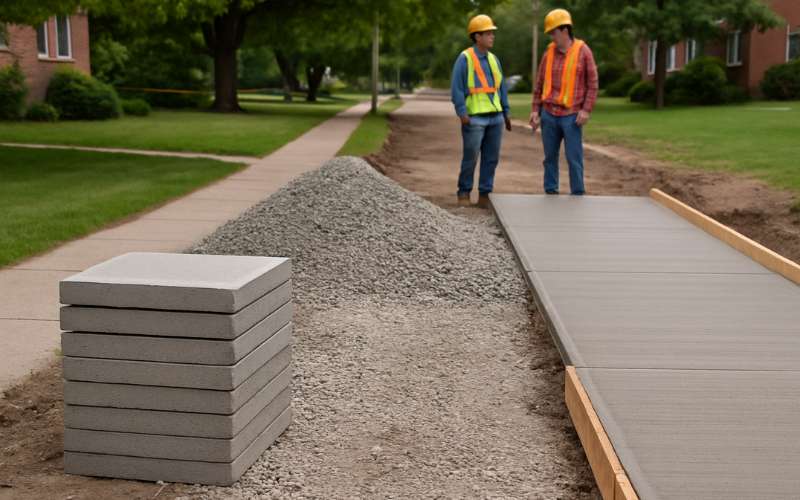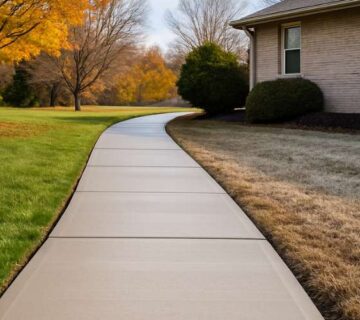Walking through your neighborhood, you may have noticed sidewalks that are cracked, uneven, or poorly maintained. These issues are not only an eyesore but also a safety risk for families and communities. Everything You Need to Know About Sidewalks Construction: Materials, Process, and Long-Term Benefits will help you understand why investing in proper sidewalks matters. A well-built sidewalk provides long-term durability, improves curb appeal, and creates safe paths that connect people daily. This guide explains materials, construction steps, and the many advantages sidewalks bring to homes and communities.
A Complete Guide to Sidewalks Construction: Key Materials, Process, and Long-Term Advantages
Sidewalks are much more than simple walking paths. They are a vital part of neighborhoods, offering safety for pedestrians and enhancing overall property value. Everything You Need to Know About Sidewalks Construction: Materials, Process, and Long-Term Benefits focuses on how the right choices in design and execution can make sidewalks durable and visually appealing. By understanding the role of materials, planning, and proper construction methods, property owners can make smart investments that prevent future repairs while providing long-term benefits for everyone who uses them.
Choosing the Right Materials
The materials used in sidewalks greatly influence their durability, cost, and appearance. Concrete is the most common choice because it balances strength, affordability, and low maintenance. However, other options exist depending on specific needs. Asphalt, for example, provides a smoother surface and faster installation, while bricks offer charm, eco-friendliness, and easy replacement for damaged sections. Natural stone is another option, admired for its elegant appearance and superior durability, though it comes at a higher price. Each material offers unique advantages, and the decision often depends on the property type, budget, and design preference.
The Planning Stage
Before construction begins, planning ensures the project is completed safely and within regulations. Contractors evaluate property lines, building codes, soil type, and water drainage. Ignoring these details can lead to cracks, uneven surfaces, or flooding problems. During this stage, professionals also determine dimensions and set elevations to ensure proper alignment. By investing time in thorough planning, property owners reduce the risk of costly repairs later. A sidewalk designed with care not only looks better but also functions effectively for decades.
Preparing the Site
Site preparation creates the foundation for a strong sidewalk. Contractors begin by marking the layout with stakes and removing any old material or unstable soil. Excavation depth is carefully calculated based on climate conditions and material selection. For example, areas with cold winters require deeper excavation to avoid frost damage. After excavation, a gravel or crushed stone base is added to provide stability and improve drainage. Proper preparation guarantees the sidewalk will withstand heavy use while resisting cracks and shifting caused by natural elements.
Construction Process
The construction process involves several critical steps that directly affect the quality of the sidewalk. Contractors first install formwork, usually made from wood or metal, to hold the shape of the sidewalk. Next, the gravel base is compacted to create a stable foundation. Once ready, concrete, asphalt, or other selected materials are poured and spread evenly. Workers then smooth and level the surface, often adding textures to improve traction. For concrete sidewalks, control joints are introduced to minimize cracking caused by temperature changes. Each step plays an important role in creating a sidewalk that is both durable and visually appealing.
Curing and Finishing
Once the material is poured, sidewalks must cure properly to gain strength and durability. Concrete sidewalks, for example, require about 28 days to fully cure. During this time, contractors keep the surface moist using water sprays or curing blankets to prevent cracks. After curing, a protective sealer can be applied to shield the sidewalk from stains, weather damage, and wear. This final stage ensures that sidewalks not only look polished but also last for years with minimal maintenance. Proper curing and finishing are crucial for long-term performance and aesthetic appeal.
Long-Term Benefits
Quality sidewalks provide many lasting benefits that extend far beyond the construction process. Safe, smooth surfaces reduce trip hazards and accidents, protecting families, children, and seniors alike. Attractive sidewalks also boost property values, making homes more appealing to potential buyers. Beyond individual properties, sidewalks enhance community life by encouraging walking, jogging, and outdoor activities. They also help manage stormwater, preventing soil erosion and flooding in neighborhoods. Everything You Need to Know About Sidewalks Construction: Materials, Process, and Long-Term Benefits highlights why sidewalks are not just infrastructure but valuable community assets.
Maintenance Tips
Even durable sidewalks require consistent care to remain in top condition. Regular cleaning prevents dirt buildup and discourages weed growth in joints. Applying a protective sealer every two to three years helps shield the surface from weather damage. Small cracks should be repaired immediately to prevent spreading and further weakening. In winter, avoid harsh chemicals, as they can erode materials and reduce sidewalk life. With simple maintenance practices, sidewalks remain attractive, functional, and safe for many years. A proactive approach to care will always cost less than major repairs.
Common Problems and Solutions
Despite careful construction, sidewalks can still develop issues over time. Cracks may appear from temperature changes, while tree roots may push sections upward. Heavy loads or poor drainage may also lead to uneven slabs. Fortunately, most problems have affordable solutions. Cracks can be sealed, uneven slabs lifted, and stains removed with cleaning. During planning, contractors can install root barriers to prevent future damage. When problems arise, quick repairs extend the sidewalk’s life and protect community safety.
Why Professional Installation Matters
While some property owners may consider DIY sidewalks, professional installation offers greater reliability and long-term value. Contractors bring experience with soil conditions, drainage, and local building codes, ensuring every step is done correctly. They also use the proper tools and techniques to deliver a polished, lasting finish. Professional work reduces the chances of costly mistakes and often includes warranties for added peace of mind. Investing in expert services ensures sidewalks are not only durable but also safe and attractive for decades to come.
Build Sidewalks That Last and Add Value
Sidewalks are an investment that pays off in safety, beauty, and property value. Everything You Need to Know About Sidewalks Construction: Materials, Process, and Long-Term Benefits makes clear why hiring professionals is a smart choice. If you’re ready to enhance your property with strong and attractive sidewalks, contact us today. Let’s build a walkway that lasts for generations.





No comment